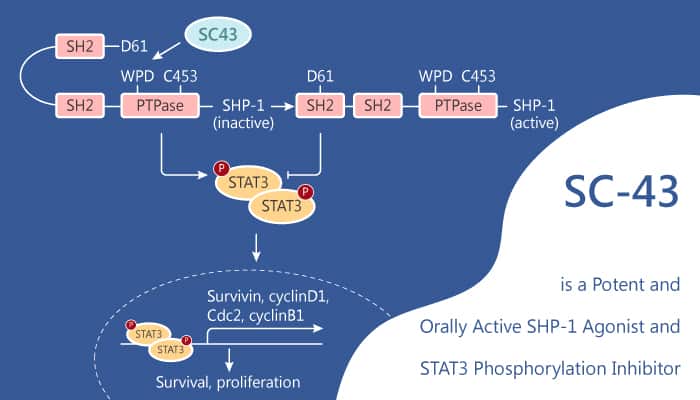Cholangiocarcinoma (CCA) is the second most common hepatic malignancy after hepatocellular carcinoma (HCC). CCAs are epithelial malignancies that arise from cholangiocytes and are aggressive behavior and advanced clinical stage. STAT3 belongs to a family of transcription factors that relay cytokine receptor-generated signals into the nucleus. STAT3 is activated by the cytokine IL-6 as well as other growth factors, including EGFR, FGFR, and PDGFR through tyrosine phosphorylation. After dimerization, STAT3 translocates into the nucleus where it activates gene transcription. STAT3 signaling mediates cell growth, proliferation, inflammatory cytokine production, cell invasion, and migration. Because of the role of STAT3 in inflammation and cancer development, targeting STAT3 is a rational treatment strategy for CCA. In addition, SHP-1, a nonreceptor protein tyrosine phosphatase (PTP) that negatively regulates p-STAT3, is also a direct target of sorafenib. In this study, SC-43, a Sorafenib derivative, is a potent and orally active SHP-1 (PTPN6) agonist.

SC-43 reveals the anti-proliferative effects in cholangiocarcinoma (CCA) cell lines in a dose-dependent manner after treating 24, 48, and 72 hours respectively. It also shows increased sub-G1 cells and G2-M arrest, indicating SC-43 induced differential apoptotic effects in these cell lines. SC-43 demonstrates a significant increase in cleaved caspase-3 and PARP levels. Meanwhile, SC-43 activates SH2 domain-containing phosphatase 1 (SHP-1) activity, leading to p-STAT3 and downstream cyclin B1 and Cdc2 downregulation. It augments SHP-1 activity by direct binding to N-SH2 and the relief of its autoinhibition. In addition, SC-43 exhibits xenograft tumor growth inhibition, p-STAT3 reduction, and SHP-1 activity elevation.
In summary, SC-43 is a potent and orally active SHP-1 agonist and has anti-fibrotic and anticancer effects. SC-43 induced apoptosis in CCA cells through the SHP-1/STAT3 signaling pathway. In conclusion, SC-43 has the potential for the treatment of CCA.
Reference:
Ming-Hung Hu, et al. Oncotarget. 2017 May 10;8(39):65077-65089.